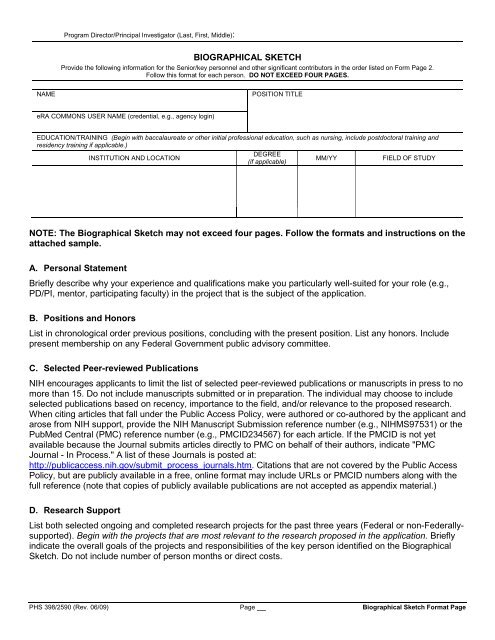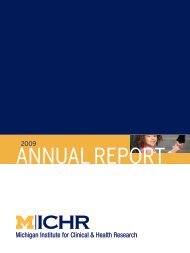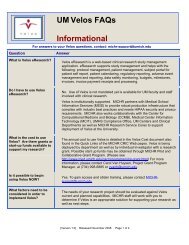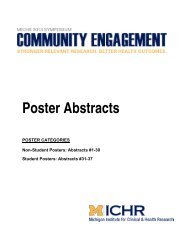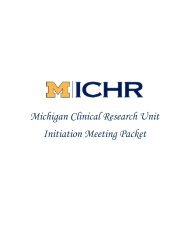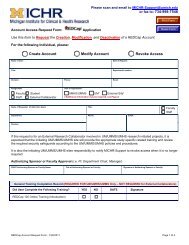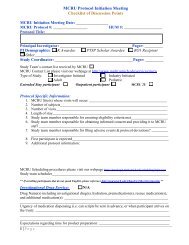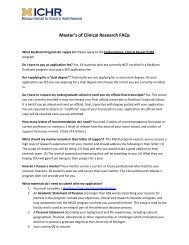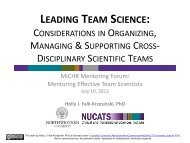NIH biosketch example
NIH biosketch example
NIH biosketch example
You also want an ePaper? Increase the reach of your titles
YUMPU automatically turns print PDFs into web optimized ePapers that Google loves.
Program Director/Principal Investigator (Last, First, Middle):<br />
BIOGRAPHICAL SKETCH<br />
Provide the following information for the Senior/key personnel and other significant contributors in the order listed on Form Page 2.<br />
Follow this format for each person. DO NOT EXCEED FOUR PAGES.<br />
NAME<br />
POSITION TITLE<br />
eRA COMMONS USER NAME (credential, e.g., agency login)<br />
EDUCATION/TRAINING (Begin with baccalaureate or other initial professional education, such as nursing, include postdoctoral training and<br />
residency training if applicable.)<br />
DEGREE<br />
INSTITUTION AND LOCATION<br />
MM/YY<br />
FIELD OF STUDY<br />
(if applicable)<br />
NOTE: The Biographical Sketch may not exceed four pages. Follow the formats and instructions on the<br />
attached sample.<br />
A. Personal Statement<br />
Briefly describe why your experience and qualifications make you particularly well-suited for your role (e.g.,<br />
PD/PI, mentor, participating faculty) in the project that is the subject of the application.<br />
B. Positions and Honors<br />
List in chronological order previous positions, concluding with the present position. List any honors. Include<br />
present membership on any Federal Government public advisory committee.<br />
C. Selected Peer-reviewed Publications<br />
<strong>NIH</strong> encourages applicants to limit the list of selected peer-reviewed publications or manuscripts in press to no<br />
more than 15. Do not include manuscripts submitted or in preparation. The individual may choose to include<br />
selected publications based on recency, importance to the field, and/or relevance to the proposed research.<br />
When citing articles that fall under the Public Access Policy, were authored or co-authored by the applicant and<br />
arose from <strong>NIH</strong> support, provide the <strong>NIH</strong> Manuscript Submission reference number (e.g., <strong>NIH</strong>MS97531) or the<br />
PubMed Central (PMC) reference number (e.g., PMCID234567) for each article. If the PMCID is not yet<br />
available because the Journal submits articles directly to PMC on behalf of their authors, indicate "PMC<br />
Journal - In Process." A list of these Journals is posted at:<br />
http://publicaccess.nih.gov/submit_process_journals.htm. Citations that are not covered by the Public Access<br />
Policy, but are publicly available in a free, online format may include URLs or PMCID numbers along with the<br />
full reference (note that copies of publicly available publications are not accepted as appendix material.)<br />
D. Research Support<br />
List both selected ongoing and completed research projects for the past three years (Federal or non-Federallysupported).<br />
Begin with the projects that are most relevant to the research proposed in the application. Briefly<br />
indicate the overall goals of the projects and responsibilities of the key person identified on the Biographical<br />
Sketch. Do not include number of person months or direct costs.<br />
PHS 398/2590 (Rev. 06/09) Page Biographical Sketch Format Page
Program Director/Principal Investigator (Last, First, Middle): Hunt, Virginia, L.<br />
BIOGRAPHICAL SKETCH<br />
Provide the following information for the Senior/key personnel and other significant contributors in the order listed on Form Page 2.<br />
Follow this format for each person. DO NOT EXCEED FOUR PAGES.<br />
NAME<br />
Hunt, Virginia Lively<br />
eRA COMMONS USER NAME (credential, e.g., agency login)<br />
huntvl<br />
POSITION TITLE<br />
Associate Professor of Psychology<br />
EDUCATION/TRAINING (Begin with baccalaureate or other initial professional education, such as nursing, include postdoctoral training and<br />
residency training if applicable.)<br />
DEGREE<br />
INSTITUTION AND LOCATION<br />
MM/YY<br />
FIELD OF STUDY<br />
(if applicable)<br />
University of California, Berkeley B.S. 05/90 Psychology<br />
University of Vermont Ph.D. 05/96 Experimental<br />
Psychology<br />
University of California, Berkeley Postdoctoral 08/98 Public Health and<br />
Epidemiology<br />
A. Personal Statement<br />
The goal of the proposed research is to investigate the interaction between drug abuse and normal aging<br />
processes. Specifically, we plan to measure changes in cognitive ability and mental and physical health<br />
across a five-year period in a group of older drug users and matched controls. I have the expertise, leadership<br />
and motivation necessary to successfully carry out the proposed work. I have a broad background in<br />
psychology, with specific training and expertise in key research areas for this application. As a postdoctoral<br />
fellow at Berkeley, I carried out ethnographic and survey research and secondary data analysis on<br />
psychological aspects of drug addiction. At the Division of Intramural Research at the National Institute on<br />
Drug Abuse (NIDA), I expanded my research to include neuropsychological changes associated with addiction.<br />
As PI or co-Investigator on several previous university- and <strong>NIH</strong>-funded grants, I laid the groundwork for the<br />
proposed research by developing effective measures of disability, depression, and other psychosocial factors<br />
relevant to the aging substance abuser, and by establishing strong ties with community providers that will<br />
make it possible to recruit and track participants over time. In addition, I successfully administered the projects<br />
(e.g. staffing, research protections, budget), collaborated with other researchers, and produced several peerreviewed<br />
publications from each project. As a result of these previous experiences, I am aware of the<br />
importance of frequent communication among project members and of constructing a realistic research plan,<br />
timeline, and budget. The current application builds logically on my prior work, and I have chosen coinvestigators<br />
(Drs. Gryczynski and Newlin) who provide additional expertise in cognition, gerontology and<br />
geriatrics. In summary, I have a demonstrated record of successful and productive research projects in an<br />
area of high relevance for our aging population, and my expertise and experience have prepared me to lead<br />
the proposed project.<br />
B. Positions and Honors<br />
Positions and Employment<br />
1998-2000 Fellow, Division of Intramural Research, National Institute of Drug Abuse, Bethesda, MD<br />
2000-2002 Lecturer, Department of Psychology, Middlebury College, Middlebury, VT<br />
2001- Consultant, Coastal Psychological Services, San Francisco, CA<br />
2002-2005 Assistant Professor, Department of Psychology, Washington University, St. Louis, MO<br />
2005- Associate Professor, Department of Psychology, Washington University, St. Louis, MO<br />
PHS 398/2590 (Rev. 06/09) Page 5 Biographical Sketch Format Page
Program Director/Principal Investigator (Last, First, Middle): Hunt, Virginia, L.<br />
Other Experience and Professional Memberships<br />
1995- Member, American Psychological Association<br />
1998- Member, Gerontological Society of America<br />
1998- Member, American Geriatrics Society<br />
2000- Associate Editor, Psychology and Aging<br />
2003- Board of Advisors, Senior Services of Eastern Missouri<br />
2003-04 <strong>NIH</strong> Peer Review Committee: Psychobiology of Aging, ad hoc reviewer<br />
2005-09 <strong>NIH</strong> Risk, Adult Addictions Study Section, member<br />
Honors<br />
2003 Outstanding Young Faculty Award, Washington University, St. Louis, MO<br />
2005 Excellence in Teaching, Washington University, St. Louis, MO<br />
2008 Award for Best in Interdisciplinary Ethnography, International Ethnographic Society<br />
C. Selected Peer-reviewed Publications (Selected from 42 peer-reviewed publications)<br />
Most relevant to the current application<br />
1. Merryle, R.J. & Hunt, V.L. (2004). Independent living, physical disability and substance abuse among the<br />
elderly. Psychology and Aging, 23(4), 10-22.<br />
2. Hunt, V.L, Jensen, J.L. & Crenshaw, W. (2007). Substance abuse and mental health among communitydwelling<br />
elderly. International Journal of Geriatric Psychiatry, 24(9), 1124-1135.<br />
3. Hunt, V.L, Wiechelt, S.A. & Merryle, R. (2008). Predicting the substance-abuse treatment needs of an<br />
aging population. American Journal of Public Health, 45(2), 236-245. PMCID: PMC9162292<br />
4. Hunt, V.L., Newlin, D.B. & Fishbein, D. (2009). Brain imaging in methamphetamine abusers across the lifespan.<br />
Gerontology, 46(3), 122-145.<br />
5. Hunt, V.L. & Sher, K.A. (2009). Successful intervention models for older drug-abusers: Research across<br />
the life-span. American Psychologist, in press. <strong>NIH</strong>MSID: <strong>NIH</strong>MS99135<br />
Additional recent publications of importance to the field (in chronological order)<br />
1. Gryczynski, J., Shaft, B.M., Merryle, R., & Hunt, V.L. (2002). Community based participatory research with<br />
late-life addicts. American Journal of Alcohol and Drug Abuse, 15(3), 222-238.<br />
2. Shaft, B.M., Hunt, V.L., Merryle, R., & Venturi, R. (2003). Policy implications of genetic transmission of<br />
alcohol and drug abuse in female nonusers. International Journal of Drug Policy, 30(5), 46-58.<br />
3. Hunt, V. L., Marks, A.E., Shaft, B.M., Merryle, R., & Jensen, J.L. (2004). Early-life family and community<br />
characteristics and late-life substance abuse. Journal of Applied Gerontology, 28(2),26-37.<br />
4. Hunt, V.L., Merryle, R. & Jensen, J.L. (2005). The effect of social support networks on morbidity among<br />
elderly substance abusers. Journal of the American Geriatrics Society, 57(4), 15-23.<br />
5. Hunt, V.L., Pour, B., Marks, A.E., Merryle, R. & Jensen, J.L. (2005). Aging out of methadone treatment.<br />
American Journal of Alcohol and Drug Abuse, 15(6), 134-149.<br />
6. Hunt, V.L, Marks, A.E., Venturi, R., Crenshaw, W. & Ratonian, A. (2006). Community-based intervention<br />
strategies for reducing alcohol and drug abuse in the elderly. Addiction, 104(9), 1436-1606. PMCID:<br />
PMC9000292<br />
7. Merryle, R. & Hunt, V.L. (2006). Randomized clinical trial of cotinine in older nicotine addicts. Age and<br />
Ageing, 38(2), 9-23. PMCID: PMC9002364<br />
8. Hunt, V.L., Jensen, J.L. & Merryle, R. (2008). The aging addict: ethnographic profiles of the elderly drug<br />
user. NY, NY: W. W. Norton & Company.<br />
9. Hunt, V.L. (2009). Contrasting ethnicity with race in the older alcoholic. TheJournals of Gerontology Series<br />
B: Psychological Sciences and Social Sciences, in press. PMCID: PMC Journal – In Process.<br />
10. Hunt, V.L. (2009). Intervening successfully with the older methadone patient. Journal of Applied<br />
Gerontology, 13(4), 67-79.<br />
PHS 398/2590 (Rev. 06/09) Page 6 Continuation Format Page
Program Director/Principal Investigator (Last, First, Middle): Hunt, Virginia, L.<br />
D. Research Support<br />
Ongoing Research Support<br />
R01 DA942367-03 Hunt (PI) 09/01/07-08/31/12<br />
Health trajectories and behavioral interventions among older substance abusers<br />
The goal of this study is to compare the effects of two substance abuse interventions on health outcomes in an<br />
urban population of older opiate addicts.<br />
Role: PI<br />
R01 MH922731-05 Merryle (PI) 07/15/05-06/30/10<br />
Physical disability, depression and substance abuse in the elderly<br />
The goal of this study is to identify disability and depression trajectories and demographic factors associated<br />
with substance abuse in an independently-living elderly population.<br />
Role: Co-Investigator<br />
Faculty Resources Grant, Washington University 08/15/09-08/14/11<br />
Opiate Addiction Database<br />
The goal of this project is to create an integrated database of demographic, social and biomedical information<br />
for homeless opiate abusers in two urban Missouri locations, using a number of state and local data sources.<br />
Completed Research Support<br />
K02 AG442898 Hunt (PI) 09/01/06-08/31/09<br />
Drug Abuse in the Elderly<br />
Independent Scientist Award: to develop a drug addiction research program with a focus on substance abuse<br />
among the elderly.<br />
Role: PI<br />
R21 AA998075 Hunt (PI) 01/01/04-12/31/06<br />
Community-based intervention for alcohol abuse<br />
The goal of this project was to assess a community-based strategy for reducing alcohol abuse among older<br />
individuals.<br />
Role: Co-Investigator<br />
PHS 398/2590 (Rev. 06/09) Page 7 Continuation Format Page


